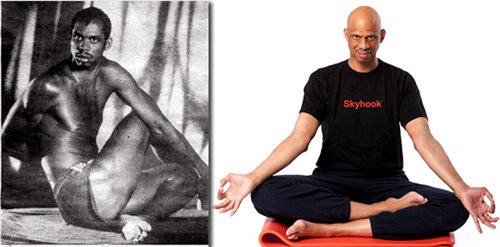
(Photo left: then; Kareem 1981. Photo right: now; Kareem 2008)
Yoga scares some people. They imagine a white-robed cult of New Age zombies sipping herbal green tea and smiling vacantly. For some, the problem is the word itself: yoga. Funny-looking, foreign and too exotic. Okay, for you we’ll call it “power-stretching†or “ultimate breathing†or “hot-bod sculpting.â€Â Is that better? Because the truth is that yoga is an excellent means of creating a more flexible and healthy body that will be less prone to injuries. And the most important part of staying fit after 50 is avoiding workout injuries that can disrupt your exercise program for weeks or even months.
I’ve been an enthusiastic practitioner of yoga since high school. Yoga is one of the reasons that I was able to play professional basketball as long as I did with as few injuries as I had. One of the first improvements I noticed was in my posture. Before yoga I’d been having lower back pains; after I started practicing the positions, my overall health improved significantly. (FYI: the practice of yoga began 3,000 years ago in India. The word “yoga†is Sanskrit and means to “union,†meaning to join together the mind, body, and spirit.)
There are many different styles of yoga. I practice Bikram yoga as well as several other styles. Beginners tend to do what I call the “yoga tour†— that is, trying out the different styles until they find the right ones for them. That’s a perfectly reasonable approach and is more likely to produce the results they’re looking for.
When Miami Dolphins Hall of Fame quarterback Dan Marino came to me to ask me how to extend his longevity and deal with all the collision-type injuries you get from playing football, I steered him to yoga; the next time I saw him he said it was absolutely helpful in his training regimen.
Those of you who studied pilates know that a large part of its foundation is based on yoga. My father started doing yoga in his late 70s and it helped him to stop his decline of flexibility. So whether you’re in top athletic shape like my friend Dan Marino or just have old achy bones like my Dad, I thought I’d give those of you who are ready to get started a few tips:
1. Be consistent. Any new endeavor requires a period of commitment. At first, you may feel awkward or self-conscious, but promise yourself that you’ll stick with it for two months. At the same time, to receive the most benefits, you’ll need to practice yoga at least three times a week.
2. It’s not a competition. As a beginner, your body needs a period of adjustment as it adapts to new demands. Don’t push yourself beyond your limits just because you see others able to do what you can’t. We don’t throw the teen that just got his driver’s license into the Indy 500. Take your time.
3. Practice with a friend. It’s easier to keep motivated if you have someone you work out with. So, if you intend to take a yoga class at your fitness club, or practice at home with a DVD, see if you can get a friend to practice with you.
I started teaching myself yoga when I was 14, from a book. At the time, there weren’t many other opportunities to learn yoga. Today there are many classes available from fitness clubs, community colleges, yoga centers and senior centers. There are hundreds of books and DVDs that can be ordered off the Internet. Today about 18 million to 20 million Americans practice yoga regularly, including everyone from children to senior citizens, from weekend warriors to professional athletes, from soccer moms to marathon-running moms.
There’s a reason yoga has grown so dramatically in popularity: it works! It’s worked for me for over 45 years and it can work for you starting today.
(Photo credit: left: Aaron Rappaport; right: John Russo)
